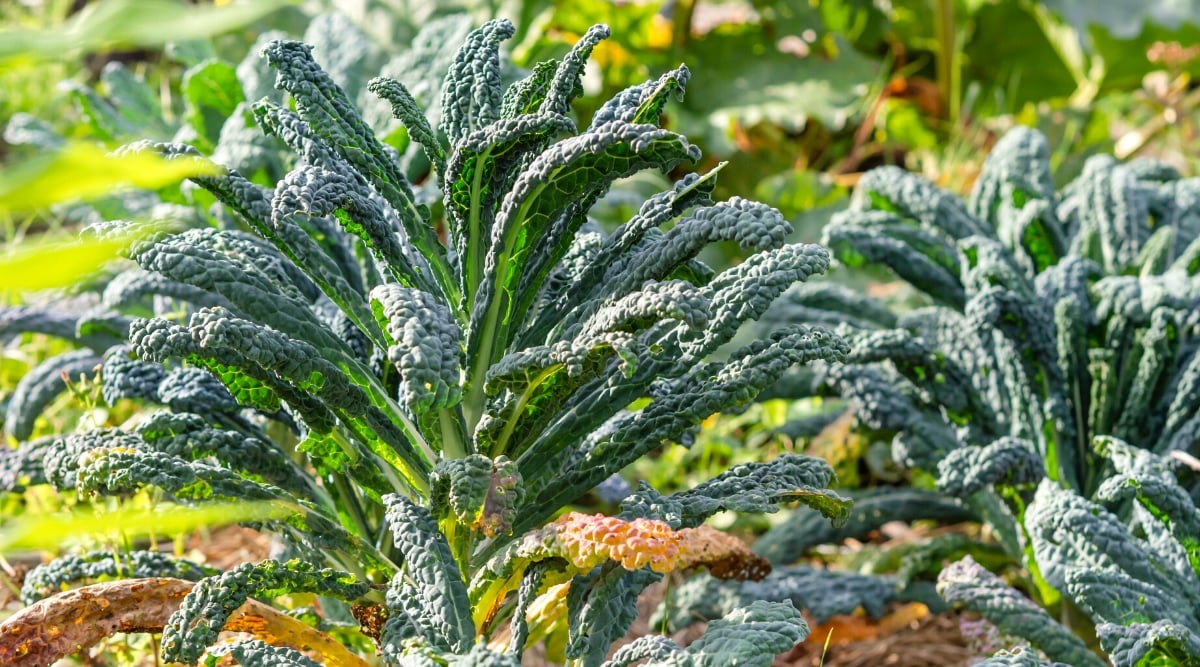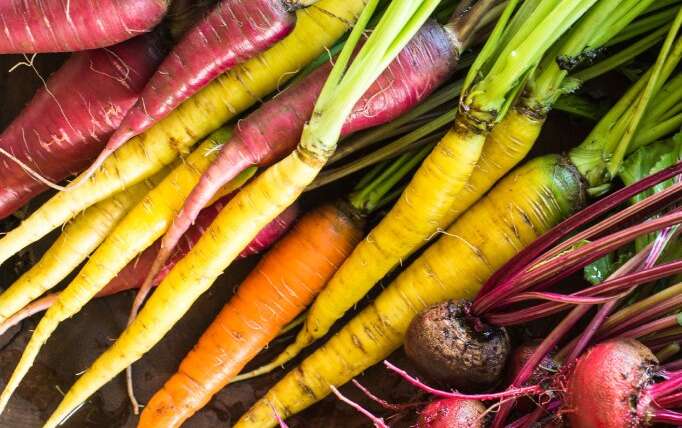As we wrap up the garden for summer and head into fall, there are plenty of opportunities for planting. From hardy brassicas to tough perennials, sowing seeds in September will prepare you for a tasty and nutritious harvest in the coming months.
These are some of the edible plants we’ll be sowing in September. Plant along with us to watch your garden thrive this fall!
‘Green Globe Improved’ Artichoke
This perennial vegetable is a must-have for zones 7-10, with reduced spines and increased production.
This perennial vegetable (in zones 7-10) is a must-have. ‘Green Globe Improved’ is an improvement on the original 1863 heirloom ‘Green Globe.’ This variety has reduced spines and better production.
Sow the seeds this September, and next spring, you’ll see the beginnings of a robust leafy plant that will throw out 3 to 5 artichokes. You can harvest the tasty unopened flower and enjoy it however you like your artichokes! Did you know that the artichokes we love to eat are actually the flower buds?
If you allow it to bloom, the bright purple flowers have fantastic ornamental value in the garden. They are large plants (up to five feet tall and eight feet wide), so give ‘Green Globe Improved’ plenty of room to do its thing.
‘Parris Island Cos’ Romaine Lettuce
 This romaine lettuce struggles in scorching summer heat but thrives in cooler fall weather.
This romaine lettuce struggles in scorching summer heat but thrives in cooler fall weather.
Scorching hot summer days make lettuce growing challenging, causing it to bolt or taste bitter. In fact, lettuce is unlikely to germinate at all when the soil temperature is over 80℉. Take advantage of the cooler days coming your way in fall, and plant tasty lettuce that you can harvest until frost.
This romaine produces classic, luscious, buttery hearts. If you like baby greens, they’ll be ready in as little as 21 days! This variety is also frost-tolerant.
‘Little Gem’ Mini-Romaine Lettuce
 This vegetable is perfect for smaller spaces, growing compact at six inches tall with sweet, crunchy leaves.
This vegetable is perfect for smaller spaces, growing compact at six inches tall with sweet, crunchy leaves.
If you lack the space for massive lettuce heads, plant the adorable ‘Little Gem’ romaine instead! This compact variety grows only six inches tall with sweet, crunchy, delicious leaves reminiscent of butterhead lettuce.
Young leaves will be ready to harvest in just 20 days, great for personal-sized salads or popping onto sandwiches.
‘Vivian’ Romaine Lettuce
 This lettuce variety produces large 16-inch tall heads and is suitable for wraps or salads.
This lettuce variety produces large 16-inch tall heads and is suitable for wraps or salads.
‘Vivian’ is similar in taste to ‘Parris Island’ but reaches maturity even faster. This lettuce produces massive heads up to 16 inches tall and 6 inches wide, ideal for lettuce wraps or as a salad base.
If your weather is still hot this September, sow lettuce seeds in a 6-cell tray placed in the shade. You can transplant seedlings into the garden once it cools down. Enjoy the baby greens early, or leave them to form firm heads before harvesting the entire thing.
‘Rosette Tatsoi’ Bok Choy
 This Asian vegetable has an intense mustard flavor.
This Asian vegetable has an intense mustard flavor.
Do you love making stir-fry? You’re missing out if you don’t grow your own bok choy. ‘Tatsoi’ is an ancient variety with an intensely delicious mustard flavor.
‘Rosette Tatsoi’ grows in a rosette shape. For a cut-and-come-again crop, pick the most mature outer leaves and leave the center of the rosette intact to keep growing. This variety will tolerate temperatures down to 15℉ (even if there’s snow on the ground!), a major bonus for cold-climate gardeners.
‘Choko’ Bok Choy
 This Chinese cabbage offers mild leaves for pickling or stir-fries.
This Chinese cabbage offers mild leaves for pickling or stir-fries.
‘Choko’ is a classic variety with mild and delicious leaves ideal for pickling or stir-fries. It produces singular heads perfect to harvest all at once. If you cut it down at the soil level, it’ll grow back to give you a second harvest!
If you sow seeds in September, this baby bok choy will be ready to harvest in less than two months, ready to toss into late fall and early winter dishes. Thanks to their compact size, they also grow well in containers.
These bok choy varieties do well in partial shade, making them perfect for plugging into those tricky spots in the garden. Like all brassicas, they are heavy feeders. Mix some compost and organic fertilizer into the soil when sowing for the best results.
‘Bloomsdale’ Spinach
 This cold-resistant spinach boasts nutrient-rich, tender leaves ready in 28 days. Ideal for successive plantings!
This cold-resistant spinach boasts nutrient-rich, tender leaves ready in 28 days. Ideal for successive plantings!
We all know spinach is good for us. It’s rich in iron and vitamins C and A. But if you haven’t tried growing it at home, you’ll be surprised how good the fresh stuff tastes. ‘Bloomsdale’ has particularly rich, tender leaves.
This variety is ready to harvest in about 28 days. Succession sow seeds starting in September every one to two weeks for a continued harvest into winter. This variety tolerates the cold down to 20℉, but you can extend the season even longer by throwing on a frost cover or growing in a cold frame. Spinach doesn’t like to be transplanted, so direct-sowing is best!
‘Easter Egg Blend’ Radish
 These mild-flavored, colorful radishes mature in 30 days and easily grow when direct-sown in the garden.
These mild-flavored, colorful radishes mature in 30 days and easily grow when direct-sown in the garden.
If you live in a cold climate, you need fall veggies that will mature quickly and tolerate a frost. ‘Easter Egg Blend’ radish comes in a beautiful mix of pinks, reds, violets, and whites and is ready to harvest in just 30 days!
This blend has a mild, pleasant flavor that complements your hearty fall dishes. For these, it’s best to direct-sow (add a bit of compost first to refresh the soil if you’re using it to replace a previous summer crop), and the fast growth rate makes it rewarding and fun to grow for kids, too.
‘Calliope Blend’ Carrot
 These carrots come in bright, vibrant colors and mature in 60 to 75 days.
These carrots come in bright, vibrant colors and mature in 60 to 75 days.
Now that you’ve got colorful radishes, add to your rainbow with multi-colored ‘Calliope Blend’ carrots. The bright colors mean they’re extra-rich in antioxidants. These pretty and crisp carrots will mature in 60 to 75 days.
They don’t mind light frost. It makes them even sweeter! If September is still dry in your area, water often to keep the soil moist after sowing the seeds. Carrot seeds won’t germinate if the soil dries out in the first two weeks of sowing. For extra protection in areas experiencing hot afternoon sun, throw a shade cloth over them after sowing.
‘Rapini’ Broccoli Raab
 This broccoli raab variety quickly matures in 45 days, providing small and peppery-flavored side shoots.
This broccoli raab variety quickly matures in 45 days, providing small and peppery-flavored side shoots.
This broccoli raab is ready to eat in as few as 45 days. Unlike regular broccoli that grows one large head, this European favorite produces small, tender side shoots with a nice peppery flavor.
‘Rapini’ Broccoli Raab will tolerate temps down to 25℉. The frost will increase the sugar content, making it even more delicious! If you need it all winter, throw on some frost protection to continue enjoying these easy-to-harvest nutritious veggies.
‘Tokyo Long White’ Onion
 These vegetables mature in 65 days, offering sweet and mild blue-green tops for fall dishes.
These vegetables mature in 65 days, offering sweet and mild blue-green tops for fall dishes.
These bunching scallions take less time to mature (65 days) than bulbing onions and can overwinter as a perennial in zones 6-9. The blue-green tops and mild white onions are sweet and yummy in all your favorite fall soups and salads.
You can sprinkle them liberally into your desired container and thin them out later (3-4 inches apart is best if you want the tender white bulbs), or sow each seed a half inch apart for great cut-and-come-again green tops.
‘Market Express’ Turnips
 This Japanese salad turnip is sweet and fruity and will be ready as baby turnips in 30 days.
This Japanese salad turnip is sweet and fruity and will be ready as baby turnips in 30 days.
‘Market Express’ is a mild white Japanese salad turnip with a sweet and fruity taste. You can enjoy them as baby turnips, perfect for veggie trays and salads in 30 days, or wait another ten days for mature, full-sized roots. Those less than five inches in diameter will be the most tender.
These turnips like soil temps around 60℉. Sow three seeds every four to six inches and thin them out to the best-looking specimens as they grow.
‘French Filet’ Bush Beans
 These green beans are tasty, quick to grow in under 60 days, and are great in warm fall climates.
These green beans are tasty, quick to grow in under 60 days, and are great in warm fall climates.
These slender, gourmet green beans are easy to grow and super delicious. They germinate best when soil temps are between 70-85℉ and are frost-sensitive, so this crop is best for gardeners with warm fall temperatures. They’re ready to eat in just under 60 days.
‘French Filet’ is productive, but you can help them produce even more by adding an inoculant when planting. You’ll love these beans in steams and sautés.
‘Wando’ Shelling Peas
 This vegetable thrives in both cold and heat.
This vegetable thrives in both cold and heat.
This yummy shelling pea doesn’t mind the cold, but luckily, it’s heat tolerant for those still enjoying hot summer days (up to 80℉). ‘Wando’ tolerates the frost and will mature in less than 70 days.
These plants grow up to 30 inches tall and appreciate a trellis or wall to grow up as they mature. Harvest when the pods are nice and plump, about three weeks after they flower.
‘Progress #9’ Peas
 These shelling peas are ideal for container gardening and produce many fat, full pods.
These shelling peas are ideal for container gardening and produce many fat, full pods.
If you garden in containers, check out ‘Progress #9’ shelling peas. These tasty peas are heavy producers that only grow about 18 inches tall.
Presoak your seeds before planting and give them some small stakes to cling to for best results. The vines are fragile, so use some sharp snips to clip the pods before enjoying the juicy peas inside.
‘King Richard’ Leeks
 Leeks thrive in cool temperatures down to 20℉ and are ready to harvest in about 75 days.
Leeks thrive in cool temperatures down to 20℉ and are ready to harvest in about 75 days.
One of Kevin’s absolute favorites for fall soups, ‘King Richard’ leeks are tolerant down to 20℉. Gardeners in warm winter climates can let them grow until next spring!
Unlike some veggies you have to harvest as soon as they ripen, leeks can be left in the garden until you want to use them. This gives you flexibility and removes some of the pressure of growing at home. ‘King Richard’ can grow up to 30 inches long and has a rich oniony flavor. Harvest them in about 75 days.
‘Gourmet Baby Greens’ Mesclun Lettuce
 This vegetable mix, with butterhead, romaine, and leaf lettuce, offers versatile options for harvest.
This vegetable mix, with butterhead, romaine, and leaf lettuce, offers versatile options for harvest.
This gourmet mix has a versatile combination of butterhead, romaine, and leaf lettuce that can be enjoyed as baby greens in only 21 days. If you have a longer fall season, you can also leave them to grow full-sized heads.
Harvest them above the soil line for tender baby greens when they reach two to four inches tall. Sow them about ½ apart and cover lightly with soil; no thinning is needed!
‘Lacinato Dinosaur’ Kale
 Dinosaur kale offers beauty and flavor for fall, tolerating winter conditions like a champion.
Dinosaur kale offers beauty and flavor for fall, tolerating winter conditions like a champion.
Also known as ‘black kale,’ these dark leafy greens provide beautiful color and excellent flavor to your fall veggie repertoire. This 18th-century heirloom can be harvested all winter long in many climates (it can handle temps down to 10℉!).
Direct-sow right into the garden or into seed trays for later transplanting. You can harvest the baby greens in 30 days or wait 60 days for mature crops. In mild climates, they may overwinter and grow as a biennial, producing flowers in their second year that you can let develop into seeds for future harvests!
Try ‘Dazzling Blue’ for an option that’s pretty enough for ornamental arrangements. It’s just as fast to mature and even more cold-hardy than other Lacinato kales. This variety has a striking purple midrib and blue-green leaves that turn violet as temperatures cool. ‘Red Russian’ is another colorful type, with red veins and oak-shaped leaves.
Common Sorrel
 This perennial vegetable is a tangy alternative to spinach and chard, thriving in poor soil.
This perennial vegetable is a tangy alternative to spinach and chard, thriving in poor soil.
If you love spinach, try this perennial alternative in zones 3 through 7! Common sorrel is tangy and citrusy, delicious in salads, and good anywhere you’d typically use spinach or chard.
This popular European vegetable grows well even in poor soil. As a perennial, it performs best when divided every two to three years. Plant sorrel now and harvest it in about 60 days.
Final Thoughts
September planting sets the stage for a thriving fall garden with an abundant harvest that lasts into winter and, for perennials, into next spring. Sow these seeds with us this fall, and keep on growing!




